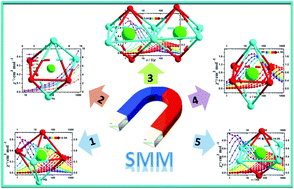Structural and magnetic studies of six-coordinated Schiff base Dy(iii) complexes†
Abstract
With the aim to tune the magnetic anisotropies of six-coordinated Dy(III) complexes, four bis-Schiff bases bearing different spacers and one mono-Schiff base were designed, namely bis(2-hydroxylnaphthalenylmethylene)hydrazine (H2L1), bis(2-hydroxylnaphthylmethylene)ethylenediamine (H2L2), bis(2-hydroxylnaphthylmethylene)-propylenediamine (H2L3), bis(2-hydroxylnaphthylmethylene)-2-methylpropylenediamine (H2L4) and 1-(3-pyridylmethyliminomethyl)-2-naphthalenol (HL5). Their reactions with DyCl3·6H2O gave five Dy(III) complexes, namely [Dy(H2L1)2(H2O)Cl3] (1), [Dy(H2L2)3/2Cl3]n (2), [Dy2(H2L3)2Cl6]·2CH3CN (3), [Dy(H2L4)2Cl2]Cl·3MeOH (4) and [Dy(HL5)(H2L5)Cl4] (5). 1, 4 and 5 are mononuclear metal complexes. 2 exhibits a two-dimensional skeleton, however, with its Dy(III) ions well separated. A dinuclear structure was found for 3, in which the two Dy(III) ions are doubly bridged through Cl− linkers. The Dy(III) ions in all metal complexes show octahedral geometries. 1–4 bear bis-Schiff base ligands with different spacers (from no spacer to –CH2CH2–, –CH2CH2CH2–, and –CH2CH(CH3)CH2–) between the two N atoms, which tune the coordination spheres into DyO3Cl3 for 1 and 2, DyO2Cl4 for 3, and DyO4Cl2 for 4. The DyO2Cl4 coordination environment can also be achieved in 5 through a mono-Schiff base. It is revealed from the magnetic measurements that 1, 4 and 5 are field-induced single-molecule magnets, and 3 is a typical zero-field single-molecule magnet. The different SMM performances of 1–5 revealed that the different sets of coordination environments (DyOxCl6−x) of these octahedral Dy(III) complexes achieved through the adjustment of the spacers in the Schiff base ligands can effectively tune their magnetic properties via affecting the magnetic easy axes and magnetic anisotropies of the Dy(III) ions. Ab initio calculations, which include the quantum tunneling rates of magnetization, g-tensors, crystal field parameters and magnetic easy axes, were carried out for interpreting the observed magnetic properties.



 Please wait while we load your content...
Please wait while we load your content...